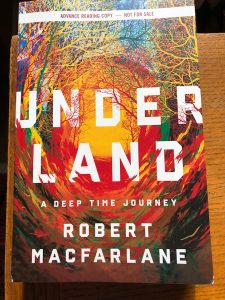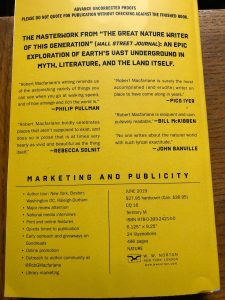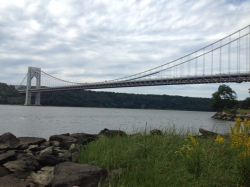New York City Winters, Then & Now—Climate Change Reflections
/0 Comments/in Art, Photography, Design, Personal history, Family, Friends, Urban Life & New York City /by Philip Turner I moved to New York City from Cleveland in early March of 1985, almost 37 years ago. In many of the winters I’ve experienced since the move east, the Hudson River would become icy, as attested to by these pictures I took in January 2015.
I moved to New York City from Cleveland in early March of 1985, almost 37 years ago. In many of the winters I’ve experienced since the move east, the Hudson River would become icy, as attested to by these pictures I took in January 2015.
Sometimes the ice would be close to shore, as seen here, with the tidal nature of the Hudson ensuring the river didn’t freeze hard. But in the ’90s, I remember extended runs when temperatures didn’t rise above freezing for days or weeks, and temps in the twenties, teens, and single digits were common. Then the ice would become more solid and fill in across the middle of the river. With the tidal shifting less impactful, the ice could stretching toward New Jersey. Someone foolhardy might’ve thought they could walk across, but that would have foolish indeed.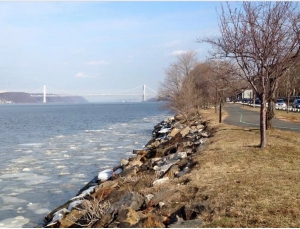
Despite the blustery cold, it was thrilling to watch and listen as the floes heaved, ground, and pitched against one another. I used to feel like I was in my own private Shackleton expedition. If you’ve read Alfred Lansing’s stirring narrative about that sojourn to the South Pole, the ships became trapped amid colossal bergs that stoved in their sides and collapsed their masts. The sailors were driven to near madness by the grinding and gnashing of the ice.
 The past several winters? Not so much, a function of planetary warming, I believe. Our winters are definitely becoming less cold. More evidence of this? Flocks of geese used to visit the Hudson shores seasonally, and leave for months at a time, flying further south for warmer climes. Now they’re resident year-round.
The past several winters? Not so much, a function of planetary warming, I believe. Our winters are definitely becoming less cold. More evidence of this? Flocks of geese used to visit the Hudson shores seasonally, and leave for months at a time, flying further south for warmer climes. Now they’re resident year-round.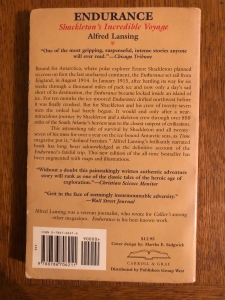
Excited for Publication Day of “The Twenty-Ninth Day: Surviving a Grizzly Attack on the Canadian Tundra”
/1 Comment/in Art, Photography, Design, Canada, Philip Turner's Books & Writing, Publishing & Bookselling /by Philip Turner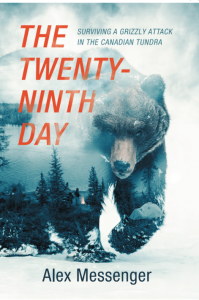 I’m thrilled that Alex Messenger’s book The Twenty-Ninth Day: Surviving a Grizzly Attack in the Canadian Tundra will officially be published tomorrow, November 12 by Blackstone Publishing, in hardcover, ebook, and in an audiobook edition read by the author. I’ve been working with Alex since 2016, so it’s very heartening to know that his book is about to reach the reading public.
I’m thrilled that Alex Messenger’s book The Twenty-Ninth Day: Surviving a Grizzly Attack in the Canadian Tundra will officially be published tomorrow, November 12 by Blackstone Publishing, in hardcover, ebook, and in an audiobook edition read by the author. I’ve been working with Alex since 2016, so it’s very heartening to know that his book is about to reach the reading public.
As editor and publisher in 2002 of the superb historical novel The Revenant: A Novel of Revenge by Michael Punke, later adapted for a Hollywood movie, it’s a happy coincidence for me to be involved with another book featuring the survivor of a near-lethal encounter with a grizzly bear. If you’ve enjoyed such books as Into the Wild by Jon Krakauer (where by contrast the young protagonist did not survive his wilderness ordeal), Admiral Richard Byrd’s Alone, and Great Heart: The History of a Labrador Adventure by James West Davidson and John Rugge, you’ll definitely enjoy Alex’s first-person chronicle.
The Twenty-Ninth Day is also a featured pick of the Midwest Booksellers Association.
For updates on Alex’s book tour, you can follow him on Twitter and Instagram @AMessengerPhoto and at The Twenty-Ninth Day website.
If you’re in Minnesota, there’s a full line-up of author events coming up:
11/12/19, 6pm, Bookstore at Fitger’s, Duluth.MN
11/23/19 Author signing at Midwest Mountaineering Outdoor Adventure Expo, Minneapolis, MN
11/23 6pm Excelsior Bay Books, Excelsior, MN
11/30/19 Author signing at Frost River, Duluth, for Small Business Saturday
12/7/19 Scout & Morgan Books, Cambridge, MN
12/8/19 Holiday Signing at Next Chapter Bookstore 11-1pm, St Paul, MN
12/14/19 Zenith Bookstore, Duluth, MN, with two other authors
Also, here are some excellent publicity hits and below them the video trailer Blackstone Publishing did to promote the book.
Duluth News Tribune, feature article
Minnesota Public Radio, interview with the author
https://youtu.be/6Mb4NJcPtiI
Appreciating Hebridean Landscapes and the Work of Scottish Novelist Neil Gunn
/1 Comment/in Art, Photography, Design, Personal History, Family, Friends, Education, Travels, Publishing & Bookselling /by Philip Turner
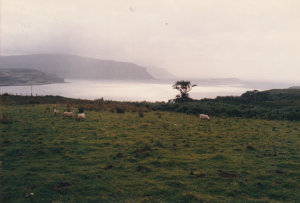 For lovers of Scotland and the Hebrides, just offshore from the stunning isle of Mull, is an even smaller island, equally beautiful and shimmering in the silvery distance, called Ulva. This post kicks off with a memorable picture I took of Ulva from Mull during a solo Scottish sojourn I made in 1986, the first of five visits I’ve made to the country. In those pre-digital days I took the photograph with film and a .35 mm Minolta camera I still own, though now use only rarely.
For lovers of Scotland and the Hebrides, just offshore from the stunning isle of Mull, is an even smaller island, equally beautiful and shimmering in the silvery distance, called Ulva. This post kicks off with a memorable picture I took of Ulva from Mull during a solo Scottish sojourn I made in 1986, the first of five visits I’ve made to the country. In those pre-digital days I took the photograph with film and a .35 mm Minolta camera I still own, though now use only rarely.
Visually, I was struck by the recognition that headlands such as these on Ulva could almost mirror each other in their profiles and their contours. I remember the silvery cloud-filled day I made this image, and a very warm day some years later, when I took more photos of Ulva; each time I felt as if the landscape had set in motion a kind of rhyming action, with cliff shapes echoing each other as they receded into the distance.
On that trip, a bookseller in Edinburgh recommended a novel, Young Art and Old Hector, by a Scottish novelist he thought I would enjoy reading. The author was Neil M. Gunn (1891-1973), and the recommendation set up a reading passion that I still cherish. I learned Gunn was a key figure in a mid-20th century flowering of Scottish writing, a kind of Celtic renaissance, that also included the poet and critic Hugh MacDiarmid. Gunn’s many novels were good, engrossing stories, often set in villages and the countryside, featuring characters—sometimes country folk, sometimes people leaving the country for town life, with young people and older folk—all of whom find they must contend with a changing social fabric, as longtime customs are giving way to a more modern society.
Then an editor with the small US publisher, Walker & Company, I found that very few of Gunn’s books had been published in the States, so I set about reading his work and acquiring rights to as many as I could get for Walker. My favorite was Blood Hunt, originally published in the UK in 1952. When I brought it out in the US in 1987 I added the reading line, “A Highland Adventure”. It seemed an apt tag line because in plot it resembled Victor Hugo’s Les Miserables, with a sympathetic fugitive being pursued by a single-minded, obsessive police official. Harboring the fugitive is old Sandy, who, as I wrote on the flap copy, “after a lifetime at sea has returned to the land of his ancestors to enjoy his remaining years in the peaceful isolation of his Highland croft. His chief companions are his collie, his cow, a few hens, and his precious library. He’s also a friend to the village lads who quickly learn they can trust him with their secrets.” Sandy is a soft touch with sympathy for the young fugitive, Allan Innes, to whom he provides sanctuary.
When it came to select an image for the cover of the Walker edition, I was delighted to offer my art director colleague the chance to review my Mull photos, and that’s how the cover ended up as it is, also shown here. Included with this post are the picture I took that first occasion; portraits of myself and my wife, painter Kyle Gallup, taken when we visited the same locale together in 1992; the book jacket of Blood Hunt in multiple views with the book’s flap copy.
On one of two visits we made to Scotland in the 1990s, Kyle and I also visited the Summer Isles*, off the west coast and further north than Mull. The Summer Isles lie roughly across from a wee village on the mainland called Achiltibuie, where we rented a self-catering cottage for two weeks; the accommodation came with two bicycles for our use, and we rode all over the area. We also bought passage on a pleasure boat journey, sailing out to and around the Summer Isles, and were enchanted by them—they are populated mostly by birds, and we saw astonishing quantities of puffins, gannets, cormorants, and skuas (as is their way, the latter species dive-bombed us, going right for our caps, which we were glad to have on our heads).
During this visit to the northwest highlands, we made a gorgeous drive on a single-track road from Achiltibuie to the nearby larger town of Ullapool—where we shopped for groceries and found a bookstore—and then motored back to Achiltibuie at sunset. The light and colors setting in to the ocean to the west were staggeringly beautiful. At the bookstore I saw a biography of Neil Gunn, which I bought and began reading during our stay. I learned that for many years Gunn had a day job as an excise inspector, that is a government official making sure that whisky** distilleries were running ship-shape and paying their taxes. F.R. Hart and J.B. Pick, co-authors of Neil Gunn: A Highland Life, wrote that in his job, Gunn was obliged to drive hundreds of miles every week all over the highlands calling on distilleries. Amid that gorgeous landscape, the biographers report that he had one favorite drive above all others: the ride between Achiltibuie and Ullapool. It was a thrill to discover we had the same taste in sublime scenery!
If you have an affinity for naturalistic writing steeped in landscape and compelling characters, I suggest you look at the work of Neil Gunn, and a key book by Gunn’s friend and colleague Nan Shepherd, The Living Mountain.
*An upcoming post on this site will be about a forthcoming book, The Summer Isles: A Voyage of the Imagination by Philip Marsden (Granta Books, London, October 2019), an engaging writer by whom I published in 1994, The Crossing Place: A Journey Among the Armenians, in the Kodansha Globe trade paperback series. In his new book, Marsden chronicles a mostly solo sailing voyage he made from his home in Cornwall in southeast England up between the east coast of Ireland and the west coast of Scotland to the Summer Isles. I’m reading a galley now, and enjoying it very much. Once I get a finished copy, with the maps included, I will write about it.
**In 1935 Neil Gunn published a nonfiction book titled Whisky and Scotland: A Practical and Spiritual Survey.
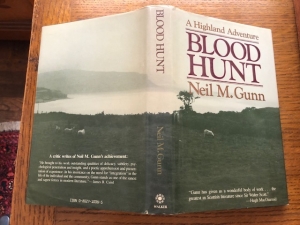
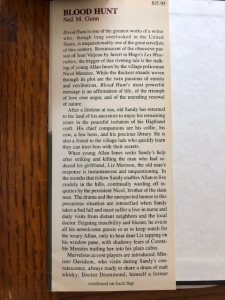
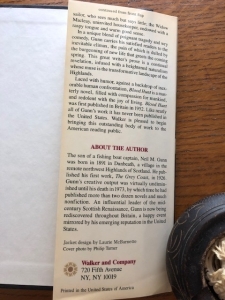
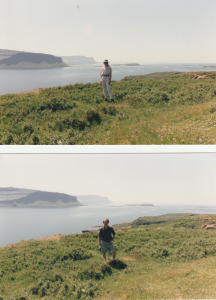
Spring Arriving in My London Nabe
/0 Comments/in Art, Photography, Design, Personal History, Family, Friends, Education, Travels /by Philip TurnerVisiting Britain, Feb 19-April 1—Books, Brexit, and Beyond
/0 Comments/in Art, Photography, Design, Personal History, Family, Friends, Education, Travels, Philip Turner Book Productions, Publishing & Bookselling /by Philip TurnerAs I recently posted on Facebook, I’m excited that my wife, Kyle Gallup, a painter, has been invited to do an artist’s residency in London for the month of March. The sponsor is the long-established British paint company Winsor & Newton. They’ve selected a British painter, and an American, Kyle, and are providing them with art materials and studios in the same building as where their paint chemists work. They want the two sides, chemists and artists, to interact with each other, and thus improve the formulation of their new line of cadmium-free watercolors. A lovely idea, really.
I am taking the opportunity to travel with Kyle, which will also allow me to attend the London Book Fair March 12-14, for which I’ve made appointments to meet with British publishers and literary agents. We are flying to Scotland tomorrow where we’ll visit friends for a few days, then begin journeying through the North of England till we reach London on March 1. I plan to write for this blog and in my social networks about being in Britain as Brexit looms. My reading material will include Underland: A Deep Time Journey by a favorite British author Robert Macfarlane, being published in the US in June by W.W. Norton. I’ve loved earlier books by Macfarlane, including The Old Ways: A Journey on Foot and Mountains of the Mind: A History of a Fascination. I’m confident that reading Underland while touring Britain and staying a month in London will be a tonic regardless of the news in the UK and from the US.
Sept 22 2018 Birthday Bike Ride
/0 Comments/in Art, Photography, Design, Bicycling, Urban Life & New York City /by Philip TurnerPhotos from the Wild, Windy Edge of March
/0 Comments/in Art, Photography, Design, Bicycling, Urban Life & New York City /by Philip Turner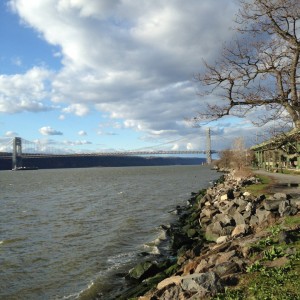 Monday dawned gray, rainy, and chilly in New York City. Yet, by around 3pm a new weather front had blown in from the south—in itself unusual—laced with rising barometric pressure, wind gusts that exceeded 40 mph, racing clouds, whitecaps on the Hudson River, higher temperatures, and bright sunshine that lasted until well after 7pm. I was out on my bike as the weather shifted, and despite getting pushed around like a paper sailboat on a lake, I managed to pedal along the river all the way up to what I call Hudson Beach and the Great Gray Bridge. Here are my best pictures from the hours that I enjoyed riding around and reveling in the elements.
Monday dawned gray, rainy, and chilly in New York City. Yet, by around 3pm a new weather front had blown in from the south—in itself unusual—laced with rising barometric pressure, wind gusts that exceeded 40 mph, racing clouds, whitecaps on the Hudson River, higher temperatures, and bright sunshine that lasted until well after 7pm. I was out on my bike as the weather shifted, and despite getting pushed around like a paper sailboat on a lake, I managed to pedal along the river all the way up to what I call Hudson Beach and the Great Gray Bridge. Here are my best pictures from the hours that I enjoyed riding around and reveling in the elements.

